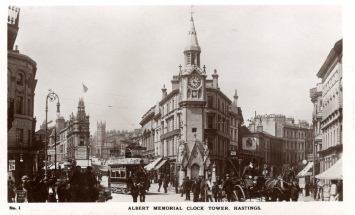
Thomas Alfred Duly of Herstmonceux sold collotype
cards that were labelled Palacette Studio, so perhaps
he also contributed photographs. Yet other cards issued
by the Palacette Studio have captions written by an
unknown hand, which may mean that an unknown
publisher issued the Palacette Studio cards, "buying in"
the pictures from a variety of photographers.
During the Great War sales of postcards in Britain became seriously depressed. Possibly to reduce his capital exposure Shoesmith decided to enter into a partnership with George Etheridge in March 1915 to sell cards jointly under the name Shoesmith and Etheridge. After this, Shoesmith seems to have ceased publishing cards on his own. From 1917 until after the war ended he served in the Royal Flying Corps as a photographer, being based in Hythe in Kent.
Where Etheridge lived in the early years of his partnership with Albert Shoesmith
is difficult to discover from Directories, but in 1913 he was living at 25 Milward
Road, moving on during the 1920’s. The 1939 Electoral Register states that his home
was at 57 St Helen's Road. However, Pike's Directories for 1938-
By 1916, Shoesmith and Etheridge were located at 154 (later also at 153) Queens Road, Hastings, which was of course Shoesmith's existing address and also the address of the Sussex Photographic Co. It is quite common to find cards of Hastings labelled "Shoesmith & Etheridge, Publishers (or "Photo Printers"), Hastings", "S. and E. Super Series" or "Published by the Sussex Photographic Co., 154 Queen's Road, Hastings" that share the same pictures and design of backs. No obvious explanation comes to mind as to why it was thought necessary to market different versions of each card.
While some of the photographs on the
early inter-
others are sepia toned. Many cards have
white borders. The captions printed in
plain capitals are centrally positioned in
the border under the photographs, usually
with a serial number to the left. Other
cards have no borders, and captions
usually at the bottom left of the
photographs. The cards closely resemble
some of the pre-
Shoesmith and the Sussex Photographic
Co., and may have been printed by the
Rotary Photographic Co. of London. One interesting card of the Lifeboat House and Fishing Quarter in Hastings has been found that is labelled Rotary Photo on the front, but has a "Shoesmith & Etheridge, Photo Printers" label on the back. It was postally used in September 1917.
One important innovation made by Shoesmith & Etheridge was the introduction in 1919 of air view cards of St Leonards and Hastings, Winchelsea and Rye. These cards complemented a series of aerial of views of Worthing, Brighton and Eastbourne that Wardell issued during the same year, and clear evidence has been found that it was Wardell who supplied Shoesmith and Etheridge with their St Leonards and Hastings views.
In addition to real photographics, sepia-
Florence Shoesmith, Albert and Rosina's elder daughter, who was known in the family as "Colonel", worked in the Queens Road shop and in some respects was the "brains" of the business. She later became a nurse, and then married an Irish doctor and moved to Athlone. On their retirement Florence and her husband went to the Canary Isles, but moved back to the UK. Nora Shoesmith, Albert and Rosina's second daughter, was a dress designer and during the Great War drove ambulances and cars for officers. Len Shoesmith served in the RAF as an electronics engineer during the Second World War.


Shoesmith & Etheridge
S&E Page 4 of 12